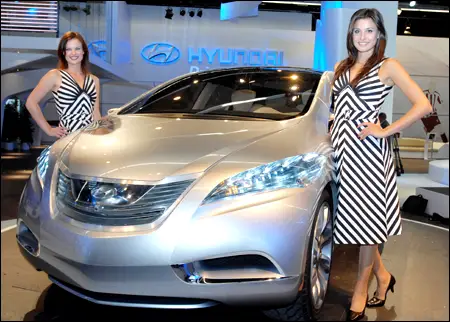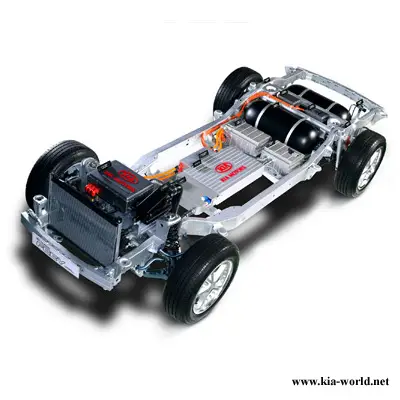DAILY - UPDATED
KIA NEWS
&
SPY SHOTS
REVIEWS
SALES REPORTS

Hyundai-Kia Launch “Clean-Cars” Project
When this year’s Frankfurt Motor Show kicked off in the German city last week, it was definitely the “clean cars” or eco-friendly vehicles, that stole the limelight of the world’s largest automobile feast.
Global carmakers are in fierce competition to develop eco-friendly cars including hybrid vehicles and fuel cell cars amid rising environmental concerns.
And in South Korea, Hyundai Motor is leading the van of the so-called environmental management.
In the automobile show attended by some 4,000 exhibitors, Hyundai Motor unveiled its third-generation hydrogen concept car “i-Blue” to join the latest global trend spearheaded by the world’s top players such as BMW and Mercedes-Benz.
Different from the first-generation fuel cell Santa Fe in 2000 and second-generation fuel cell Tucson in 2004, both of which were altered from existing models, i-Blue is the first concept car designed as an “all-fuel cell” vehicle from the outset.
The brand name i-Blue also signifies it is a “pollution-free” vehicle which does not emit any contaminants such as carbon dioxide, while the word “blue” represents the clean image of water.
Hyundai Motor also displayed its advanced technology to lighten the size and weight of core auto parts for smaller fuel cell cars in the future with the i-Blue, a mid-size CUV (crossover utility vehicle) that combined the merits of sedans and minivans.
With one fueling, i-Blue can run up to 600km on an output of 100kW and boasts a maximum speed of 165km per hour. It also has upgraded technology from Hyundai Motor’s first- and second-generation fuel cell cars.
Kia environmental management
Amid widespread concerns over environmental problems such as global warming and heightened public awareness on the issue, the term “environmental management” has become a key factor for sustainable growth of enterprises.
Hyundai-Kia Automotive Group Chairman Chung Mong-koo also declared the start of environmental management in 2003, adopting it as one of his principal management strategies in the 21st century.
While the company has also exerted continuous efforts to enhance the fuel efficiency of conventional gasoline and diesel cars, Hyundai Motor focused more in recent years on the development of cars that use alternative energy sources.
With its fuel cell Tucson, in particular, the top South Korean automaker took part in a project with the U.S. Department of Energy in 2004 to set up the infrastructure for hydrogen fuel stations and test-drive hydrogen cars along with other global carmakers.
Hyundai Motor has also made efforts to commercialize hybrid cars, which use two or more distinct power systems such as electricity together with gasoline or diesel engines to achieve better fuel economy and reduce pollutants in exhaust gas.
For such research and development (R&D) activities for future vehicles, Hyundai Motor set up the Environmental Technology Research Institute in Yongin, Gyeonggi Province, in September 2005.
“From the development of new products to production, sales and after-sales service, the institute became the Mecca of environmental technologies to cope with the ever-strengthening environmental regulations around the world,” said a company spokesman.
Hyundai-Kia Motors now funnels billions of dollars into hybrid and fuel cell vehicles since it first embarked on the development of futuristic vehicles in 1995. It set aside some $2.76 billion along with Kia Motors for this year’s R&D activities.
Since the first introduction of its hybrid concept cars “FGV” and “FGV” in 1995 and 1999, the company has already brought its accumulated technologies into several of its models such as the “Avante”(Elantra) and “Verna”(Accent) in 1999 and 2000, respectively.
In 2004, under a joint project with the Ministry of Environment, the company also had 50 “Click” (Getz) hybrid models road-tested and provided a total of 312 hybrid vehicles including the “Verna” and Kia Pride to public organizations in Seoul.
Hyundai Motor sold 369 hybrid vehicles to public organizations in 2006 and it plans to sell 3,390 more across the country by 2008, advancing the “era of hybrid cars”.
“We’re stepping up efforts to churn out hybrid cars from 2009”, the spokesman said. “By 2010, we will also develop a new hybrid model which improves fuel efficiency by up to 50 percent and reduces gas emissions by 30 percent that of existing vehicles”.
For Brighter Future
Hyundai Motor has come up with a plan to begin mass production of hybrid cars in 2009 and bring up its annual production to 300,000 per year by 2015. But experts stressed that the company should make more efforts to achieve the goal.
Dr. Cho Cheol, a researcher at the Korea Institute for Industrial Economics and Trade (KIET), said in a recent report that it would be probably after 2011 at the earliest for South Korean carmakers _ in fact, Hyundai Motor _ to begin mass production.
Cho, however, expected that the country’s level of technology for hybrid cars could reach 70-75 percent of that of Japan by 2010 and 90-95 percent by 2020, up from the current 60-65 percent.





FREE ENERGY ENGINE IS THE CLEANES WAY TO DRIVE